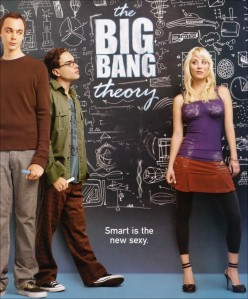What comes to mind when someone says “scientist”? A common image is a sullen white-haired gentleman in a white lab coat playing with equipment in a spotless lab. Often science is perceived as being for the elite, a strange phenomena that cannot be understood nor fathomed. It is not seen to affect everyday life at all.
The Big Bang Theory is a comedy about scientists. Banished is the idea of white lab coats and clinical laboratories. These scientists are young, vibrant and loving life. Although the Big Bang Theory has been a highly successful show, the method of science communication is questionable. The Big Bang Theory was not made to educate the public about science, but has been extremely successful in bringing science and scientists to the attention of the public (Riesch 2014).
The dorky, loveable characters communicate that scientists are not to be feared but are intelligent people who are often intimidated by social interaction. The show also argues that science plays a major role in everyday life. It is a platform for scientific concepts to be communicated and the common ideas of science to be explained. On occasions, the scientific principles presented are explained to Penny, a girl without a thorough understanding of science, in a style that is easy to understand. At other times, the scientific concepts are explained with nothing but jargon and condescension.
Despite the communication methods, the science is accurate. The writers of the show rely on the expertise of a physics consultant, David Saltzberg and neurobiologist Mayim Bialik. Mayim Bialik plays the character Amy Farrah Fowler, a neurobiologist.
There is a danger that the some of the negative preconceptions of science and scientists reinforced by the show. The general idea of scientists has been changed, however, there are some characteristics that stay. Scientists are thought to be socially awkward and to have difficulty communicating. There is also the belief that science is for the elite.
The Big Bang Theory is an entertaining sitcom. It has revolutionised the general public’s perception of science and scientist. The science, although accurate, is not always communicated in the most effective style. It must be noted that this show is not designed to educate. As Mayim Balik says, it is important to remember this show is for entertainment (Russo 2012).

Bibliography
Riesch, H. (2014). “Why did the proton cross the road? Humour and science communication.” Public Understanding of Science: 1-8.
Russo, G. (2012). “Turning Point: Mayim Bialik.” Nature 485(669).



